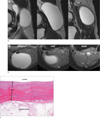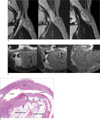Abstract
Purpose
We retrospectively compared plain radiographic and MR imaging findings of acutely ruptured and unruptured Baker's cysts to determine which factors cause rupture of BCs.
Materials and Methods
The MR findings for 44 Baker's cysts (non-ruptured Baker's cysts in 30 patients and ruptured Baker's cysts in 14 patients) were evaluated. On the MR images, the characteristics of the Baker's cysts, meniscal tears, and the quantity of joint effusions were evaluated. On plain radiographs, the grade of osteoarthritis of the affected knee was evaluated.
Results
There was no statistically significant difference with respect to the size of Baker's cysts, meniscal tears, and the grade of osteoarthritis between ruptured and unruptured Baker's cysts. The wall thicknesses, inner signal intensities, inner septations, and the quantity of joint effusions were statistically different between the ruptured and unruptured Baker's cysts.
Conclusion
The most significant imaging finding which influences the rupture of a Baker's cyst is the quantity of the joint effusion of the affected knee. In management of the patients with Baker's cysts, the quantity of joint effusions should be kept in mind for preventative or treatment trials involving ruptured Baker's cysts.
Figures and Tables
 | Fig. 1MRI and histopathologic findings of an unruptured Baker's cyst in a 60-year-old woman. Serial sagittal T2-wighted (a) and serial axial fat-suppressed proton-weighted (b) MR images show homogeneous fluid content and no inner septation in the Baker's cyst. There is no significant pericystic edema or fluid collection in the popliteal fossa. On histopathology (c), the cyst is composed of a dense collagenous, fibrous wall with even thickness. No significant inflammatory reaction and septal fibrosis of pericystic adipose tissue is noted. |
 | Fig. 2MRI and histopathologic findings of a ruptured Baker's cyst in a 55-year-old woman. Serial sagittal T2-wighted (a) and serial axial fat-suppressed proton-weighted (b) MR images show inhomogeneous fluid content and multiple septations in the Baker's cyst. Marked pericystic edema and fluid collection are noted around the Baker's cyst and in the posterior aspect of the upper calf. On histopathology (c), the cyst is composed of a dense collagenous, fibrous wall with variable thickness and inflammatory cell infiltration. Marked inflammatory reaction and septal fibrosis (arrows) in pericystic adipose tissue are noted. |
References
1. Miller TT, Staron RB, Koenigsberg T, Levin TL, Feldman F. MR imaging of Baker cysts: association with internal derangement, effusion, and degenerative arthropathy. Radiology. 1996. 201:247–250.
2. Janzen DL, Peterfy CG, Forbers JR, Tirman PFJ, Genant HK. Cystic lesions around the knee joint: MR imaging findings. AJR Am J Roentgenol. 1994. 163:155–161.
3. Fielding JR, Franklin PD, Kustan J. Popliteal cysts: a reassessment using magnetic resonance imaging. Skeletal Radiol. 1991. 20:433–435.
4. Torreggiani WC, Al-Ismail K, Munk PL, et al. The imaging spectrum of Baker's (popliteal) cysts. Clin Radiol. 2002. 57:681–691.
5. Langsfeld M, Matteson B, Johnson W, Wascher D, Goodnough J, Weinstein E. Baker's cysts mimicking the symptoms of deep vein thrombosis: diagnosis with venous duplex scanning. J Vasc Surg. 1997. 25:658–662.
6. Natarajan A, Amarvathi R, Philip B, Rozario A. Ruptured Baker's cyst simulating deep venous thrombosis. Trop Doct. 2003. 33:106–107.
7. Ozgocmen S, Kaya A, Kocakoc E, Kamanli A, Ardicoglu O, Ozkurt-Zengin F. Rupture of Baker's cyst producing pseudothrombophlebitis in a patient with Reiter's syndrome. Kaohsiung J Med Sci. 2004. 20:600–603.
8. Klovning J, Beadle T. Compartment syndrome secondary to spontaneous rupture of a Baker's cyst. J La State Med Soc. 2007. 159:43–44.
9. Schimizzi AL, Jamali AA, Herbst KD, Pedowitz RA. Acute compartment syndrome due to ruptured Baker cyst after nonsurgical management of an anterior cruciate ligament tear: a case report. Am J Sports Med. 2006. 34:657–660.
10. Lindgren PG, Willén R. Gastrocnemio-semimembranosus bursa and its relation to the knee joint. I. Anatomy and histology. Acta Radiol Diagn (Stockh). 1977. 18:497–512.
11. Doppman JL. Baker's cyst and the normal gastrocnemiosemimembranosus bursa. Am J Roentgenol Radium Ther Nucl Med. 1965. 94:646–652.
12. Wilson PD, Eyre-Brook AL, Francis JD. A clinical and anatomical study of the semimembranosus bursa in relation to popliteal cyst. J Bone Joint Surg. 1938. 20:963–984.
13. Lindgren PG, Rauschning W. Clinical and arthrographic studies on the valve mechanism in communicating popliteal cysts. Arch Orthop Trauma Surg. 1979. 95:245–250.
14. Sansone V, de Ponti A, Paluello GM, del Maschio A. Popliteal cysts and associated disorders of the knee: critical review with MR imaging. Int Orthop. 1995. 19:275–279.
15. Stone KR, Stoller D, De Carli A, Day R, Richnak J. The frequency of Baker's cysts associated with meniscal tears. Am J Sports Med. 1996. 24:670–671.
16. Szer IS, Klein-Gitelman M, DeNardo BA, McCauley RGK. Ultrasonography in the study of prevalence and clinical evolution of popliteal cysts in children with knee effusions. J Rheumatol. 1992. 19:458–462.
17. Carpenter JR, Hattery RR, Hunder GG, Bryan RS, McLeod RA. Ultrasound evaluation of the popliteal space: comparison with arthrography and physical examination. Mayo Clin Proc. 1976. 51:498–503.
18. Meire HB, Lindsay DJ, Swinson DR, Hamilton EBD. Comparison of ultrasound and positive contrast arthrography in the diagnosis of popliteal and calf swellings. Ann Rheum Dis. 1974. 33:221–224.
19. Kellgren JH, Lawrence JS. Epidemiology of chronic rheumatism. 1963. Philadelphia, Pa: Davis.
20. Chaudhuri R, Salari R. Baker's cyst simulating deep vein thrombosis. Clin Radiol. 1990. 41:400–404.
21. Calvisi V, Lupparelli S, Giuliani P. Arthroscopic all-inside suture of symptomatic Baker's cysts: a technical option for surgical treatment in adults. Knee Surg Sports Traumatol Arthrosc. 2007. 15:1452–1460.
22. Wigley RD. Popliteal cysts: variations on a theme of Baker. Semin Arthritis Rheum. 1982. 12:1–10.
23. Pedowitz RA, Gershuni DH, Crenshaw AG, Petras SL, Danzig LA, Hargens AR. Intraarticular pressure during continuous passive motion of the human knee. J Orthop Res. 1989. 7:530–537.
24. Burger C, Mönig SP, Prokop A, Rehm KE. Baker's cyst - current surgical status. Overview and personal results. Chirurg. 1998. 69:1224–1122.




 PDF
PDF ePub
ePub Citation
Citation Print
Print





 XML Download
XML Download